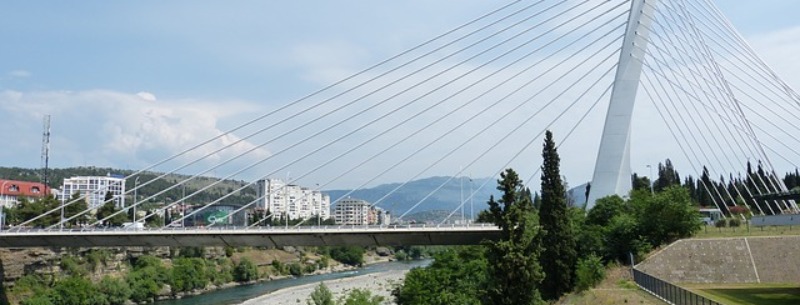Podgorica, capital city of Montenegro
Podgorica is the largest city and capital of Montenegro. More than 150,000 people call the city home, and the area has been inhabited since the Roman and Illyrian eras. Although it lacks the eye candy typical of many other European capitals, the city is worth a visit for its historical value, cafe culture and vibrant nightlife.
One of the most enchanting areas of the city is the Old Turkish Town, known as Stara Varos to locals. The district is mysterious, colorful and full of curving, narrow streets to explore. Visit the old clock tower and take time to explore the many mosques in the area. Most are open to visitors outside of communal prayer times.
The ruins of the old town of Nemanja are also worth exploring. Check out the old Turkish bridge that spans the Ribnica, then climb the stairs to Moraca on the outfall of the river.
Montenegro’s Parliament sits across the street from a charming and pleasant park. If the high energy of the city starts to get to you, head to the park like the locals does to relax and unwind. In the center of the park is a monument to King Nikola, the country’s only king, who reigned from 1910 until 1918.
King Nikola’s castle is open to visitors, and the on-site museum offers a small but interesting collection of historic artifacts.
The central square of Trg Republike is another great place to soak in the local flavor. Located next to Hercegovacka Street, the area is one of the hippest in Podgorica. There are many inexpensive restaurants, shops and clubs, and locals often start their evenings in the district. Citizens also like to gather in Rimski Trg, the city’s newest square. The surrounding area is known for its intimate cafes, eclectic boutiques and trendy restaurants.
Picnicking is a popular activity in the city, and locals often enjoy eating outdoors at Gorica Hill, Skadar Lake and Mareza.
Cafe culture is alive and well in Podgorica. On a summer day, the sidewalks are filled with patrons sipping strong espressos and cappuccinos at cafes. There are dozens of coffeehouses in the center of the city, and new and trendy cafes open seemingly every month, especially in the newer Vectra district.
At night, locals love to dance at the city’s many clubs and bars. It is illegal to play music past 1:00 am, but the parties often move to basement clubs at that time, and locals tend to stay out until the sun rises. The playlists range from international dance hits to folk music from the former Soviet state, but there are also many clubs that highlight up-and-coming local bands.
Most of the country’s museums and traditional sights are located in the old capital of Cetinje, just 50 kilometers away from Podgorica. The historic city makes a great side-trip form the capital. While in Cetinje, do not miss a chance to explore the 18th-century monastery, home to relics from John the Baptist, Saint Peter of Cetinje and Petar II Petrovic. The Ethnographic Museum, State Museum and National Museum of Montenegro are also worth visiting to get a better understanding of the country’s rich history and culture.
Podgorica Geographical Location
Podgorica is the largest city in Montenegro and is located where the Ribnica and Moraca Rivers meet in the southeast of the country.
The approximate population of Podgorica is 187,100.
Podgorica Language
Montenegrin is the official language of Montenegro but Serbian is the most commonly spoken language.
Podgorica Predominant Religion
- 74% Orthodox Christian
- 18% Muslim
- 3.5% Catholic
- 3% Unspecified
- 1% Atheist
- 0.5% Other
The Montenegrin and Serbian Orthodox Churches are the two most common form of orthodox Christianity in Montenegro.
Podgorica Currency
The Euro is the official currency of Montenegro.
Podgorica Climate
The summers in Podgorica are usually hot and the winters are mild. Heavy precipitation usually occurs during the cooler months but rarely in the form of snow.
Podgorica Main Attractions
- Monastery Dajbabe
- Duklja
- Nemanjin Grad
Other Attraction in Podgorica
- Montenegrin National Theater
- Medun
- Vranjina
- St George’s Church
